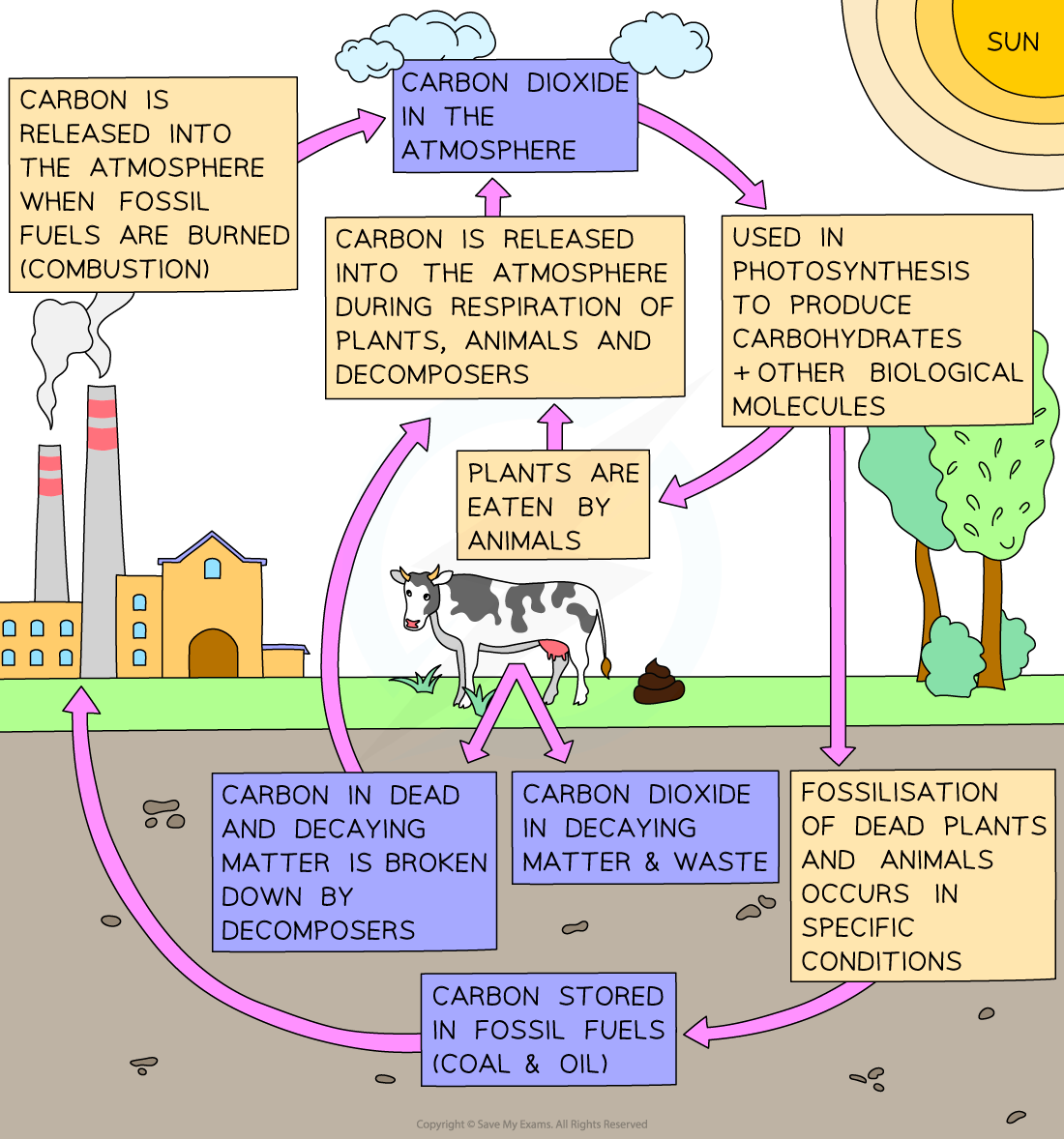Syllabus Edition
First teaching 2024
First exams 2026
Carbon Cycle (DP IB Environmental Systems & Societies (ESS)): Revision Note
Carbon cycle
Many different materials cycle through the abiotic and biotic components of an ecosystem
All materials in the living world are recycled to provide the building blocks for future organisms
Elements such as carbon are not limitless resources
There is a finite amount of each element on the planet
Elements need to be recycled in order to allow new organisms to be made and grow
Carbon is constantly being recycled around the biosphere so that the total amount of carbon in the biosphere is essentially constant
Carbon is transferred from one form to another by the various processes in the carbon cycle
Organic and inorganic carbon stores
Organisms, crude oil and natural gas contain organic stores of carbon
Organic stores refer to the carbon-containing compounds found in organisms and fossil fuels
For example, carbon in these stores may exist as carbohydrates in organisms or hydrocarbons in fossil fuels
Inorganic stores exist in the atmosphere, soils and oceans
Inorganic stores refer to reservoirs of carbon that exist in other non-living components of the biosphere
For example, carbon in these stores may exist as carbon dioxide or carbonates
Equilibrium and residence time
A carbon store is in equilibrium when absorption (uptake) is balanced by the release
For example, the carbon stored in trees through photosynthesis is balanced by the carbon released during respiration
Residence time is the average time that a carbon atom remains in a store
Without human interference like mining, the residence time in fossil fuels would be measured in hundreds of millions of years
Carbon flows in ecosystems
Carbon flows between stores in ecosystems through various processes
The main processes include:
Photosynthesis (transformation)—plants absorb CO2 and convert it into organic compounds (carbohydrates)
Cellular respiration (transformation)—both plants and animals release CO2 during respiration
Feeding (transfer)—animals consume organic matter, transferring carbon through the food chain
Defecation (transfer)—carbon is returned to the soil through waste products
Death and decomposition (transfer)—decomposers break down dead organisms, releasing carbon back into the soil
Other processes include:
Fossilisation—if animals and plants die in conditions where decomposing microorganisms are not present, the carbon in their bodies can be converted, over millions of years and significant pressure, into fossil fuels such as peat and coal
Aquatic organisms that die also form sediments on the sea bed
These can go on to form other fossil fuels like oil and gas
Combustion—when fossil fuels are burned, the carbon locked within them combines with oxygen to form CO₂, which is released into the atmosphere

Carbon sequestration
Carbon sequestration is the process of capturing atmospheric CO2 and storing it in solid or liquid forms
For example, trees naturally sequester carbon by absorbing CO2 during photosynthesis and storing it in their biomass
Organic matter can be fossilised over millions of years to form coal, oil and natural gas, resulting in carbon being stored underground
Ecosystems as stores, sinks or sources
Ecosystems can act as stores, sinks or sources of carbon depending on the balance between inputs and outputs
Net accumulation of carbon or net release of carbon is determined by the difference between total inputs and outputs
For example:
Young forest ecosystem: acts as a sink, as photosynthesis exceeds respiration, leading to net uptake of CO2
Mature forest ecosystem: acts as a store, with carbon cycling between living organisms, soil and atmosphere
Forest destruction (fire or deforestation): acts as a source, releasing stored carbon back into the atmosphere
Examiner Tips and Tricks
Don’t be overwhelmed by the carbon cycle—it’s actually quite simple:
Carbon is taken out of the atmosphere by photosynthesis
It is passed on to animals and decomposers by feeding
It is returned to the atmosphere by respiration; in plants, in animals and in decomposing microorganisms
In addition, it is returned by combustion of fossil fuels
Make sure you are able to identify what each arrow represents in any diagram of the carbon cycle.

Unlock more, it's free!
Did this page help you?